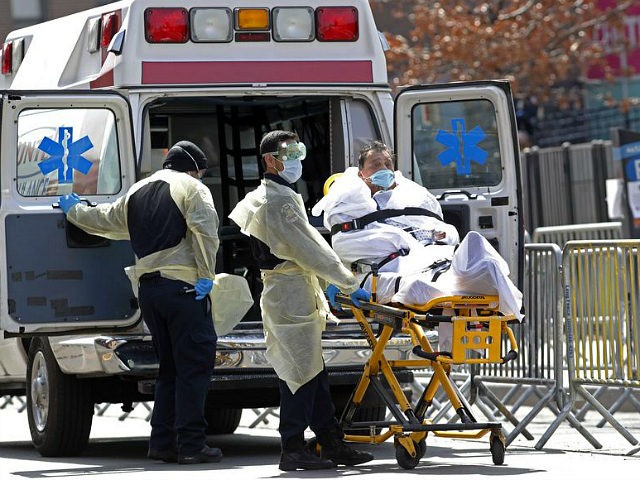The Institute for Health Metrics and Evaluation (IHME) released an update of its coronavirus model on Monday that dropped peak hospitalization projections for the United States by 34 percent in three days, from 86,479 total hospital beds needed to 56,831 total hospital beds needed.
The IHME admitted in an update accompanying the release that the dramatic drop in projected peak hospitalization resources required was the result of the inclusion of three days of actual hospitalization data from April 10-12 that was remarkably different from the projections for those days released just three days earlier on Friday, April 10. A review of the April 13 release of the IHME model late Monday showed an even lower total hospital bed requirement at the peak date (56,831) than the 59, 592 projected in the update released earlier in the day:
- For the US, the predicted peak date for hospital resource use could be around April 14, with COVID-19 patients potentially requiring 59,592 total hospital beds (estimate range of 13,060 to 191,692) – with 15,696 ICU beds (estimate range of 5,162 to 45,374) – and 14,089 invasive ventilators (estimate range of 4,046 to 42,253). The average projected total hospital bed need is now lower than the April 10 release (a mean prediction of 86,379, with an estimate range of 24,290 to 232,948); as mentioned above, this change is related to the updated hospitalization-to-death ratios estimated across states. [emphasis added]
- Based on the current data and model, several states may be experiencing their peak hospital use or have recently experienced this peak (April 7-9); these include New York, New Jersey, Michigan, Illinois, and Louisiana. Conversely, below are some states with projections pointing to high total hospital bed need, as well as other key hospital resources, that may peak between now and the end of April:
As Breitbart News reported, the IHME model had a similar dramatic reduction in projected deaths last Wednesday when that number plunged by 25 percent from 81,766 on April 5 to 60,415 on April 8.
The IHME model also included an increase in the number of COVID-19 deaths projected, from 61,545 in the April 10 update of the model to 68,841 in the April 13 update:
At the national level, projected cumulative COVID-19 deaths could reach 68,841 (estimate range of 30,188 to 175,965) across states during the epidemic’s first wave. Today’s release is somewhat higher than the average US predictions for cumulative COVID-19 deaths published on April 10 (61,545, with an estimate range of 26,487 to 155,315), though the uncertainty intervals overlap considerably. This change is at least partially driven by higher cumulative estimates for Massachusetts and New York, reflecting the latest COVID-19 death data that are publicly available.
The April 13 update also included the current list of states that “could have the highest cumulative COVID-19 death tolls through the epidemic’s first wave.”
At the top of the list is New York, which has 14,542 COVID-19 projected deaths, up 1,079 from the April 10 projection of 13,463 deaths.
The model now projects the following number of COVID-19 deaths in the six states it says will have the next highest death tolls:
Massachusetts: 8,219
Connecticut: 5,426
Florida: 4,748
New Jersey: 4,407
Georgia: 3,718
Texas: 2,704
The IHME model projects more COVID-19 deaths in Texas (2,704) — which currently has 286 COVID-19 deaths — than Michigan (2,373) — which currently has 1,479 COVID-19 deaths — a reflection of the model’s treatment of the two state’s differing social distance policies. Texas currently has not closed non-essential services, while Michigan has.

COMMENTS
Please let us know if you're having issues with commenting.